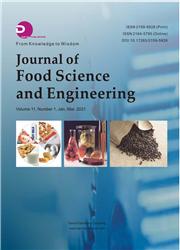Effect of Roasting and Germination on Proximate, Micronutrient and Amino Acid Profile of Breadnut Seed (Artocarpus camansi) Flour
引用次数: 2
Abstract
The proximate, micronutrient and amino acid profile of roasted and germinated breadnut seed flour were evaluated. Fresh mature fruits (1.5 kg) of breadnut were purchased from Relief market in Imo State, Nigeria. The breadnut seeds were divided into three portions for different unit operations, namely raw, roasted and germinated. Samples were analyzed for proximate, minerals and amino acids compositions. Statistical significance was set at p < 0.05. Protein (13.80%) and fat (7.90%) content were significantly higher (p < 0.05) in germinated breadnut seeds; fibre (2.20%) and ash (7.20%) were significantly higher (p < 0.05) in roasted breadnut seed while carbohydrate (75.85%) and moisture (11.05%) were significantly higher (p < 0.05) in raw breadnut. Micronutrient composition shows that iron (74.35 mg/100g) was higher in roasted breadnut seed, phosphorous (12.95 mg/100g) and zinc (30.4 mg/100g) were higher in germinated breadnut seed flour while calcium (0.04%), magnesium (0.05%), vitamin A (0.27%) and vitamin C (0.85%) were higher in raw breadnut. All the essential amino acids except norleucine were present in the breadnut in varying quantities. Between roasting and germination, essential acids; valine < histidine < isoleucine < thronine < tryptophan were more in germinated breadnut seeds while leucine < lysine < phenylalanine < methionine were higher in roasted breadnut seed flour. The use of roasting and germination should be used in processing breadnut seeds. The use of breadnut seed flours as composite flour in food production may help to provide protein and micronutrient among the vulnerable groups.烘焙和萌发对面包籽面粉中微量元素和氨基酸含量的影响
对烘焙和发芽后的面包籽粉进行了近似、微量营养素和氨基酸谱的评价。新鲜成熟的面包果(1.5公斤)是从尼日利亚伊莫州的救济市场购买的。将面包树种子分成三部分进行不同的单元操作,即生的、烤的和发芽的。分析了样品的近似物、矿物质和氨基酸组成。p < 0.05为差异有统计学意义。萌发后的面包仁蛋白质(13.80%)和脂肪(7.90%)含量显著高于对照组(p < 0.05);烘培后的面包仁的纤维含量(2.20%)和灰分含量(7.20%)显著高于对照组(p < 0.05),生的面包仁的碳水化合物含量(75.85%)和水分含量(11.05%)显著高于对照组(p < 0.05)。微量元素组成表明,烤面包籽中铁(74.35 mg/100g)含量较高,发芽面包籽粉中磷(12.95 mg/100g)和锌(30.4 mg/100g)含量较高,生面包籽中钙(0.04%)、镁(0.05%)、维生素A(0.27%)和维生素C(0.85%)含量较高。除去甲亮氨酸外,所有必需氨基酸都以不同的量存在于面包中。在烘烤和发芽之间,必需酸;萌发后的面包籽中以缬氨酸<组氨酸<异亮氨酸<苏氨酸<色氨酸较多,而烘焙后的面包籽粉中以亮氨酸<赖氨酸<苯丙氨酸<蛋氨酸较多。在加工面包树种子时应采用烘烤和发芽的方法。在粮食生产中使用面包籽粉作为复合面粉可能有助于为弱势群体提供蛋白质和微量营养素。
本文章由计算机程序翻译,如有差异,请以英文原文为准。
求助全文
约1分钟内获得全文
求助全文

 求助内容:
求助内容: 应助结果提醒方式:
应助结果提醒方式:


